Focaccia
Focaccia (Italian pronunciation: [foˈkattʃa]; Ligurian: fugassa [fyˈɡassa]) is a flat oven-baked Italian bread[1] similar in style and texture to pizza; in some places, it is called "pizza bianca".[2][3][4] Focaccia can be served as a side dish or as sandwich bread.
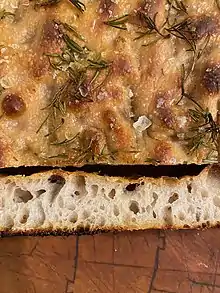 | |
| Type | Flatbread |
|---|---|
| Place of origin | Italy |
| Main ingredients | High-gluten flour, oil, water, salt, yeast |
Etymology
In Ancient Rome, panis focacius[1] was a flat bread baked on the hearth.[5] The word is derived from the Latin focus 'hearth, place for baking'.[6] The basic recipe is thought by some to have originated with the Etruscans, but today it is widely associated with Ligurian cuisine.
Outside Liguria, the word usually refers to the Genoese variants.[7] In Genoese, it is called fügassa. In Barese, it is called fecàzze.
The first attestation of the word focaccia appears in 1300.[8]
Focaccia is sometimes considered to be a kind of pizza,[lower-alpha 1] though focaccia is left to rise after being flattened, while pizza is baked immediately.[lower-alpha 2]
Regional Variants
Focaccia has countless variations along the Ligurian coast, from the biscuit-hard focaccia secca to the corn-flour, oily, soft Voltri version,[11][12]), some bearing little resemblance to the Genoese version.
An extreme example is focaccia col formaggio 'focaccia with cheese', also called focaccia di Recco or focaccia tipo Recco, which is made in Recco, near Genoa. This version has stracchino cheese sandwiched between two layers of paper-thin dough.[13]
Other versions have a surface covered with sauce or ham; there are also sweet versions with cream, fruits and gianduia cream.
Focaccia genovese
Focaccia genovese, marked by its finger-sized holes on its surface (ombrisalli in Genoese dialect)[14] is brushed or sprinkled with olive oil, coarse salt, and sometimes water before the final rise.[14][15]
In Genoa, focaccia is eaten in the morning at breakfast or during the day. It is often dipped in milk or in cappuccino at breakfast and eaten warm and wet.[14]
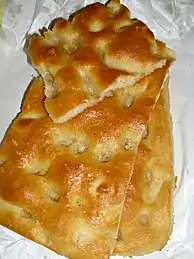
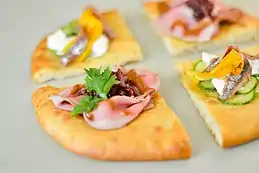
Other Variants

In Northwest Italy, a popular variant is focaccia dolce 'sweet focaccia', which is sprinkled lightly with sugar, and may include raisins or honey.[16] In Northeast Italy, focaccia veneta 'Venetian focaccia' is typical for Easter: it is based on eggs, sugar and butter and it is similar to panettone and pandoro.
In the South Tyrol and the Austrian village of Krimml, Osterfochaz (in Krimml Fochiz) is a traditional Easter gift from godparents to their godchildren. It is made slightly thinner in the centre so that dyed eggs can be placed there.[17]
Focaccia al rosmarino
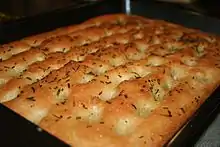
Focaccia al rosmarino 'focaccia with rosemary' is topped with rosemary.[9][18][19][20] It may be served as an antipasto, table bread, or snack.[21][22][23][24] Whole or sliced fresh rosemary leaves may be used,[18] as can dried rosemary.[25] It may be garnished with sprigs of fresh rosemary after baking[19] and sprinkled with salt.[25] Potato rosemary focaccia is often called "potato pizza" in New York City.[26]
Although rosemary is the most common herbs used to flavor focaccia,[27] sage (focaccia alla salvia) is also used.[19]
Focaccia al rosmarino may have a moist texture, and the exact recipe varies.[28] It may be savory or sweet.[28] It is typically baked, although it is sometimes fried.[28] Garlic[18] or basil may be added.[29] It is sometimes served accompanied with slices of prosciutto crudo.[30][31] It may be used in the preparation of sandwiches.[20][32]
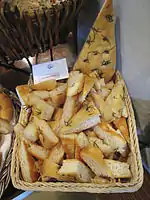 Slices of focaccia al rosmarino
Slices of focaccia al rosmarino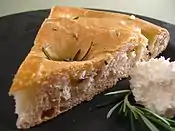 A close-up view of focaccia al rosmarino
A close-up view of focaccia al rosmarino
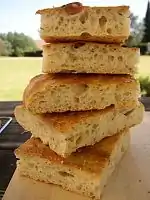 Focaccia con salvia (focaccia with sage)
Focaccia con salvia (focaccia with sage).jpg.webp) Focaccia with rosemary and cheese
Focaccia with rosemary and cheese
See also
Notes
- "Focaccia with Rosemary; Yield: 1 (12-inch [30cm]) pizza"[9]
- "What is the main difference between pizza and focaccia? The flattening of the dough, how long you take to roll out the dough, as well as the cooking time. Focaccia sits and rises before being baked. It is only put in the oven when the dough finishes rising. Pizza is placed in the oven immediately." – Gabriele Bonci[10]
References
- "Panis focacius". Archived from the original on 2017-07-12. Retrieved 2008-12-30.
- Riolo, A. (2012). The Mediterranean Diabetes Cookbook. American Diabetes Association. p. 260. ISBN 978-1-58040-483-9.
- Fraioli, J.O. (2009). Pizza & Wine: Authentic Italian Recipes and Wine Pairings. Gibbs Smith, Publisher. p. 81. ISBN 978-1-4236-1250-6.
- Simonis, D. (2010). Italy. Country Guide Series. Lonely Planet. p. 150. ISBN 978-1-74220-352-2.
- "A Short History of Focaccia Bread". Big History. WordPress. Retrieved 2012-03-22.
- Oxford Latin Dictionary (Oxford: Clarendon Press, 1982, 1985 reprinting, p. 718.
- Liguria!, That's. "Focaccia genovese, the taste of Liguria! | That's Liguria!". Retrieved 2020-12-24.
- Toso, Fiorenzo (2015). Piccolo Dizionario Etimologico Ligure - L'origine, la storia e il significato di quattrocento parole a Genova e in Liguria. Zona. ISBN 9788864385778.
- Whitson, C.; Gjesteland, T.; Widen, M.; Hansen, K. (2015). Passion for Pizza: A Journey Through Thick and Thin to Find the Pizza Elite. Agate Publishing, Incorporated. p. pt419. ISBN 978-1-57284-746-0.
- Whitson, C.; Gjesteland, T.; Widen, M.; Hansen, K. (2015). Passion for Pizza: A Journey Through Thick and Thin to Find the Pizza Elite. Agate Publishing, Incorporated. p. pt73. ISBN 978-1-57284-746-0.
- "La focaccia di Priano: una delle più buone in assoluto - Mentelocale". web.archive.org. 2015-01-20. Retrieved 2020-12-24.
- "Focaccia di Voltri". Oggi - Cucina (in Italian). Retrieved 2020-12-24.
- "Focaccia di Recco". Academia Barilla. Retrieved 9 November 2018.
- Rossi, Sergio (2013). Focaccia genovese. Genova: Sagep. ISBN 978-88-6373-258-0. OCLC 956047034.
- Massimo Alberini, Giorgio Mistretta, Guida all'Italia gastronomica, Touring Club Italiano, 1984, p. 192
- "Focaccia Bread". Archived from the original on 3 May 2012. Retrieved 22 March 2012.
- "Ostern". Familien feiern Feste. Retrieved 2018-09-24.
- Bertoli, F.B.; Mauriello, F.M.R. (2011). From a Rectory Kitchen. XULON Press. p. 15. ISBN 978-1-61904-695-5.
- Orsini, G.; Orsini, J.E. (2007). Italian Baking Secrets. St. Martin's Press. p. 113. ISBN 978-0-312-35820-4.
- Deseran, S.; Weaver, J. (2013). Picnics: Delicious Recipes for Outdoor Entertaining. Chronicle Books LLC. p. 21. ISBN 978-1-4521-2848-1.
- "In via Saluzzo un locale consacrato al mollusco". La Stampa (in Italian). November 2, 2015. Retrieved March 4, 2016.
- Rossi, L.; Verdi, D.; Gialli, G. (2014). Ricette del giorno: Antipasti. Ricette del giorno (in Italian). Bibliotheka Edizioni. p. pt41. ISBN 978-88-98801-59-6.
- Klein, D.M. (2001). The Mediterranean Vegan Kitchen: Meat-free, Egg-free, Dairy-free Dishes from the Healthiest Place Under the Sun. HP Books. p. 191. ISBN 978-1-55788-359-9.
- Marcangelo, J.; Birch, C. (1984). Italian Vegetarian Cooking. Inner Traditions/Bear. p. 94. ISBN 978-0-89281-343-8.
- Desert Island Dishes. Infinite Ideas Series. Infinite Ideas. 2012. p. 32. ISBN 978-1-908984-16-6.
- Reinhart, P. (2010). American Pie: My Search for the Perfect Pizza. Potter/TenSpeed/Harmony. p. 235. ISBN 978-1-60774-090-2.
- Sauvage, J. (2015). Gluten-Free Wish List: Sweet and Savory Treats You've Missed the Most. Chronicle Books LLC. p. 59. ISBN 978-1-4521-4389-7.
- The Illustrated Step-by-Step Cook. Look & cook. DK Publishing. 2010. pp. 392–393. ISBN 978-0-7566-7507-3.
- Barnett, A. (1996). Examining Food Technology. Examining Food Technology Series. Pearson Education. p. 44. ISBN 978-0-435-42062-8.
- Mib, Ftse. "Focaccia al rosmarino e prosciutto". Ticino News (in Italian). Retrieved March 4, 2016.
- "Spuntini veloci: focaccia con fichi e caprino" (in Italian). Blogo. September 20, 2011. Retrieved 4 March 2016.
- Madison, D. (2014). The New Vegetarian Cooking for Everyone. Potter/TenSpeed/Harmony. p. pt391. ISBN 978-1-60774-554-9.
Further reading
| Wikibooks Cookbook has a recipe/module on |
| Wikimedia Commons has media related to Focaccia. |
- Pane, pizze, focacce e torte salate. Voglia di cucinare (in Italian). Giunti Demetra. 2010. p. 229. ISBN 978-88-440-3944-8.

